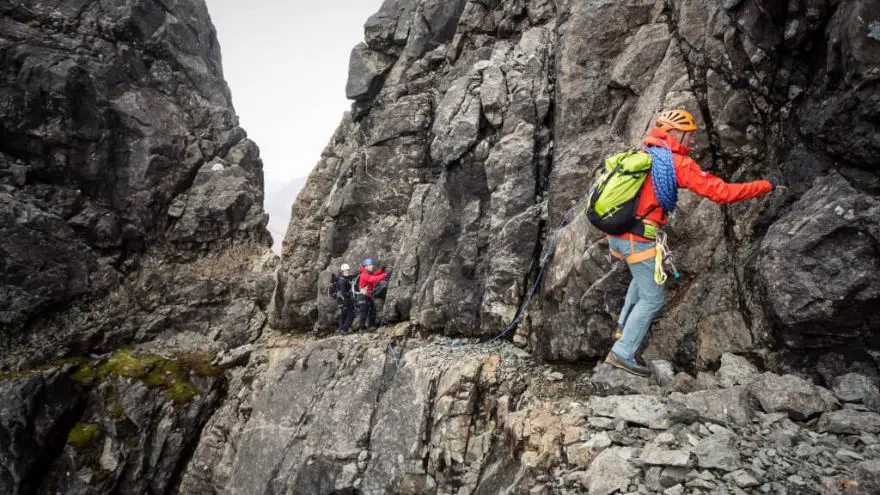What is Scrambling in Hiking: Beginners Guide
 What is Scrambling in Hiking: Beginners Guide
gearweare.net
What is Scrambling in Hiking: Beginners Guide
gearweare.net
Scrambling in the kitchen and scrambling in hiking are very different. Sometimes you can’t just simply walk up to the summit of a mountain. There may be rock climbing, bouldering, or scrambling involved.
If you are new to the sport these are probably new terms for you.
Continue reading to learn about rock scrambling, scramble classes, and more.
Table of Contents
What Is Scrambling in Hiking?
Before we get started, let’s talk about hiking. Hiking is walking through mountains, forests, or trails. There are many different difficulty levels that involve different terrains and levels of inclination. All in all, it’s done on two feet.
However, there are some trails that have sections you can’t pass without enlisting the help of all four limbs. This is rock scrambling. The terrain becomes too rocky and inclined for you to walk up. While this might sound difficult, there are all different classes (or difficulties) of scrambling.
What Are the Different Classes of Scrambling in Hiking?
During a mountain scramble, you will encounter many different levels of difficulty, which are rated from 1-5. The rating system also varies around the world, but today we will use the US system. We will start with a class 2 scramble because a class 1 scramble is pretty much just walking between scrambles.
A class 2 scramble is not very difficult. You will need to use your hands a couple of times, and watch your footing, but you won’t be needing to calculate every move. There is very little exposure. You could fall, but it likely wouldn’t be too painful.
A class 3 scramble is a bit more intense. You will be using all four of your limbs to scale the rocks with a few technical, well-thought-out moves. There is more exposure and a fall from here could possibly break a bone.
Class 4 scrambling becomes much more difficult. In many cases, you will use rock climbing accessories or at least a rope. The terrain is exposed and a fall during this climb could result in death.
As you may have guessed, class 5 scrambling is usually left to the professionals. It is very technical and should never be attempted without the correct gear.
How Do You Practice Scrambling?
The best way to practice rock scrambling is to get outside and do it. If you are just starting out, stick to easy scrambles. Once you become comfortable with these, you can attempt to scramble more inclined paths.
One important thing to remember is to have the proper gear and to pay attention to the weather. If there is snow, or if it recently rained, there are some scrambles that should not be attempted.
If you feel more comfortable practicing indoors before going on your big adventure, you can join a rock climbing gym. Most rock climbing walls are more vertical than a scramble, but they still provide great practice for hand and footing placement.
Here are 4 tips to remember when scrambling:
- Wear appropriate shoes. Depending on the difficulty, hiking boots may be too clunky and approach shoes might be your best bet.
- Grab and test your next move before putting all of your weight on it.
- Maintain at least 3 points of contact with the terrain at all times.
- Remember that descending is more difficult than ascending.
What Should I Bring to Scramble?
As you’ve seen, some classes of rock scrambling are mild. For classes 1 and 2, you don’t need any special gear besides what you should already have with you when hiking. This includes a great pair of hiking shoes, a first aid kit, and other hiking essentials.
When you start getting into more complex scrambling classes, you’ll need a few more accessories. You will need ropes, helmets, harnesses, carabiners, belays, anchors, hexes, etcetera.
Knowing the conditions of the scramble you are going to will help you to pack the necessary items. These are just a few probable items you will need.
How Is Scrambling Different From Climbing and Bouldering?
Bouldering and scrambling are similar. They both include hiking and a mild form of climbing. However, the climbing terrains are different.
When bouldering, you are climbing over large, typically smooth, rocks. The drop-offs and exposure are usually minimal. Some of the boulders can be quite large and will require you to take a moment to step back and decide how you will climb them. It requires a decent amount of strength and agility.
Depending on the class of scramble you attempt, some are very similar to climbing. Scrambling can be done with a minimal incline or with an intense incline. In most cases, climbing involves a rock face, ropes, harnesses, and other gear. In many rock climbing adventures, there’s no walking involved, just climbing.
Our Final Tips!
Now that you fully understand what rock scrambling in hiking is, you may realize that you have done it before! Many uphill trails include at least one or two mountain scrambles.
As you can see, some scrambling classes require little-to-no preparation or equipment while others can be life-threatening.
Either way, it is important to always have the correct gear and to not attempt something without proper conditioning or until you feel comfortable with it.











